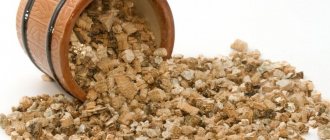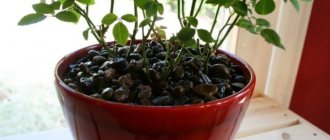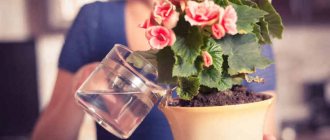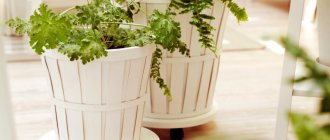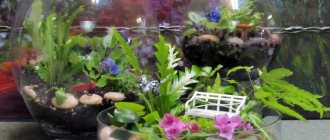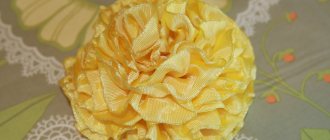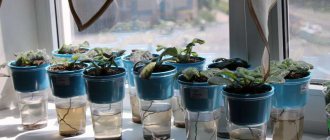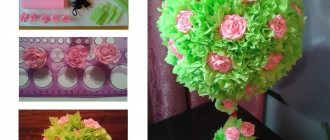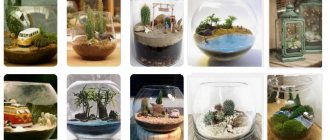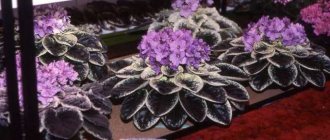This is not the first time I have noticed in shopping centers or on the windowsills of businesses that pebbles or stones are placed on TOP of pots with house plants.
Why is this being done?
Pebbles in flower pots perform not only decorative functions. And this is really beautiful. After all, sea pebbles look stylish, you can choose them in one color, white for example.
But pebbles also prevent the evaporation of moisture from the surface of the earth, and in large rooms where air conditioners operate, dry air is simply necessary.
Also, from my practice, I can say that when midges and other unnecessary living creatures disappear from the pots, the plant feels much better.
And yet, when watering a plant, earthen holes often form from the stream of water, and pebbles allow you to keep the soil at the same level, smoothing out such unnecessary impact. Thus, protecting the roots from exposure, the pebbles now perform a protective function.
It depends on how they are placed. The pebbles are for drainage. If they are placed on the bottom, this is so that the moisture does not stand in the pot and comes out through the holes.
If pebbles are placed on the surface, this is necessary so that the moisture does not evaporate quickly, that is, after watering, the moisture that was in the ground is retained.
There are also pebbles for decoration.
In general, a similar procedure is used in gardens in all different flower beds and flower beds to reduce the growth of grass and many ubiquitous weeds, which my wife successfully applied, covering almost the entire garden with fine gravel, in principle it is very convenient.
And in closed spaces, such as shopping centers, cinemas and simply in public places, this is a design solution, a kind of decor that emphasizes the style of this room. Well, at home, “God himself ordered” to add some beautiful, multi-colored pebbles or seashells to your favorite flower or exotic palm tree.
In this case, mulching the soil in the pot was done to make the composition even more decorative, although natural stone or its imitation would fit in here much better than an unnatural pink scattering. As noted, mulch is poured onto the surface of the soil for beauty, to reduce the evaporation of moisture from its surface, and also to prevent the growth of fungi (mold, for example). Mulch the soil with expanded clay, beautiful glass, natural and artificial pebbles, and even sand. The advantage of such material, in my opinion, is that the plant can be watered less often, especially this will solve the problem when you are not away. The downside is that it is very difficult to control the humidity under such a layer of mulch, especially in winter, when due to negative factors (little sunlight, hot radiators, dry air), the root system of plants rots and breathes poorly, especially when growing plants in pure peat soil. It is especially difficult on such days for succulents, like those in the photo, which in the fall and winter need the soil to completely dry out until the day of the pot, and the soil should not remain damp for a very long time. Here you need a “tough hand”. But it will be good for desert cacti, which are not watered at all from autumn to spring; such mulch will not cause any special problems, if, of course, in the summer you also follow the watering rules and the necessary lighting.
Everyone, even the most inexperienced gardener, knows that when planting a houseplant in a container, drainage must be done. However, not everyone knows that installing a drainage layer in a bowl is not as simple as it seems at first glance. Why do indoor plants need drainage, what layer of drainage should be poured and what materials should be used? There really are a lot of questions. Let's try to figure it out and start from the very basics.
So, drainage for indoor plants is a system whose main function is to remove excess moisture. It includes both the flower pot itself, equipped with special holes in the bottom, and a special layer of water-permeable materials. In addition, the drainage system also includes soil that has water- and breathable properties.
Perhaps all lovers of indoor flora understand why drainage is needed. Under natural conditions, rainwater passes freely through the soil, nourishing plants, but without stagnating. The excess goes deep underground, forming groundwater. In addition, not only the above-ground part of the plant (trunk, branches, leaves), but also the underground (root system) must be supplied with air. And if in the natural environment there are no problems with this - oxygen and other necessary gases reach the roots with water and through the soil, then in home growing conditions the respiration of the root system is difficult.
The dense materials from which modern flower pots are made practically do not allow air to pass through. And where there is no air flow, the water begins to stagnate and turn sour, putrefactive processes occur, and pests multiply. All this ultimately leads to disease and death of the plant. That is why proper drainage is one of the most important steps when planting indoor flowers.
Is drainage really necessary? But what about those plants that grow in a humid environment (for example, cyperus) or those that, on the contrary, do not need frequent watering (cacti and succulents)? It's safe to say that all indoor plants need drainage, but the drainage system may vary. This depends both on the type of home flower and on the container in which it will be planted.
Materials
The main materials used to construct the drainage layer are:
- expanded clay,
- broken brick,
- clay shards, fragments of pottery,
- Styrofoam,
- pebbles, small crushed stone, gravel,
- charcoal,
- perlite, vermiculite
The use of each of them has both its pros and cons, which are sometimes overlooked.
Expanded clay
Perhaps the most popular material for drainage, sold in all supermarkets and specialized flower shops. The direct purpose of expanded clay is construction insulation, but the material is so well suited for creating a drainage layer that it has become widely used in floriculture.
Expanded clay or expanded clay gravel are particles of foamed and baked clay. The size of expanded clay fractions can be different - from coarse to small, almost sandy. In floriculture, as a rule, medium-fraction expanded clay (from 5 to 20 mm) is used.
One of the valuable properties of expanded clay, like other clay materials, is the ability to accumulate moisture and release it when necessary. Thus, an optimal water balance is maintained in the substrate.
Advantages of expanded clay used as a drainage material:
- availability and low price,
- light weight,
- ability to absorb water,
- durability (service life is at least 4-5 years).
However, using expanded clay also has its disadvantages. For example, according to some gardeners, it is capable of changing the acid-base balance of the soil, which negatively affects the health of the green pet.
[!] Sometimes it is useful to sprinkle expanded clay onto the surface of the substrate, eliminating overheating of the soil and excessive evaporation from its surface. However, in some cases this can lead to disruption of air exchange and the appearance of mold.
Recently, expanded clay enriched with microelements has appeared on the counter of flower shops. It’s hard to say whether it’s a miracle product or an advertising ploy to increase sales. You can only try it in practice and share your findings.
Broken brick
Red brick is a building material made from clay, so the properties of red brick chips are very similar to expanded clay. If, for some reason, it is not possible to buy expanded clay, you can completely get by with broken bricks, arranging a drainage layer from this material.
Clay shards, fragments of pottery
Another readily available material for drainage is shards and broken pottery. Some gardeners collect broken cups and plates, using them later to create a drainage layer.
And this is quite justified: they are light in weight, do not absorb or retain moisture. The only disadvantage of the fragments is the sharp corners, which can easily injure you, so it is better to work with such drainage material while wearing thick gloves.
Styrofoam
Recently, a new trend has emerged among flower growers - using pieces of polystyrene foam as drainage. And while some people are distrustful of this synthetic material, others, without hesitation, fill the bottom of a flower pot with it.
Polystyrene foam is, in fact, foamed, cellular plastic, and it is used everywhere, from construction to packaging of various goods. Foam plastic, as a drainage material, has many advantages:
- availability,
- sterility (does not create a favorable environment for the development of fungi),
- lack of absorption.
Polystyrene foam does not absorb or release moisture at all, which, in some cases, is its undeniable advantage. If the grower needs a drainage layer that retains water, a little hydrogel can be mixed into the pieces of polystyrene foam.
However, this material also has some disadvantages, for example:
- the ability of roots to grow through the foam (which makes it difficult to remove during transplantation),
- too light weight.
The last property of the material creates some inconvenience when using it in light plastic pots: unstable dishes with a weak base can tip over under the weight of the plant. On the other hand, the lightness of polystyrene foam is an undoubted advantage when filling bulky ceramic dishes. This material will not add weight to an already heavy flower pot.
Pebbles, crushed stone, gravel
Another free drainage material used by many indoor plant lovers is small pebbles: pebbles, crushed stone or gravel. The use of small fragments of stones is quite justified - they allow water to pass through perfectly without retaining or absorbing it.
What materials are suitable for arranging drainage
When preparing to plant a houseplant, it is worth considering that it is not necessary to buy expanded clay or other drainage material. It can be taken from scrap materials or some natural components. Let's try to consider all the options for creating the correct planting method and what can be used from available means to achieve the required level of drainage.
Expanded clay for flowers
Expanded clay is most often used to create the required level of drainage. It can be purchased at specialized gardening stores.
The material consists of small lumps of clay. But their distinctive features are that they have a fairly porous structure and low weight. Today there are several categories of expanded clay on sale, each of which differs in the size of the lumps. So, there are varieties with a diameter not exceeding 5 mm, and there are also especially large ones - up to 2 cm.
Before using expanded clay, you need to make sure that its size will be larger than the size of the drainage holes. Otherwise, it will fall out of the pot when rearranging the flower.
Crushed stone, pebbles and gravel
You can personally store pebbles or small pebbles in the form of gravel or crushed stone from the river coast. True, they should be divided by size in order to obtain a fairly uniform drainage material. In addition, the following manipulations must be carried out over river pebbles or gravel:
- Pre-sort out any loose debris.
- Rinse thoroughly under running water.
- It is also advisable to pour boiling water over it or bake it in the oven to carry out the disinfection process.
This is done to ensure that the soil mixture does not contain any pathogenic bacteria, spores or fungi, as well as infections that could negatively affect the life of the house plant.
This drainage can be used several times. But of course, if the pebbles are to be reused, they must also be disinfected.
Broken brick
If you don’t want to buy drainage material from stores, and you have brick or its fragments on your farm, you can use them for potted plants. A whole brick can be crushed into small pieces of the desired size. And when small fragments are obtained or this is already a breakage from the building material, its sharp edges should be rounded so that the root system of the plant is not damaged by them.
It should be noted that clay brick shards are best suited for those plants that accumulate moisture in the foliage and trunk, as well as for succulents. In this case, you can do without special drainage holes at the bottom of the pot.
Ceramic shards
In any home there is a battle of dishes. It can be saved up first and then used to pour it into the bottom of the pot as drainage.
Due to the fact that such ceramic ware fragments have a high density and hardness, but are also porous enough to absorb moisture, they are able to prevent the soil from drying out. In addition, they can be used for a long time by placing them several times in flower pots. But do not forget to disinfect when reusing.
Coconut fiber
From natural materials, coconut fibers can be used in pots. Their advantages are as follows:
- Coconut fibers are able to quite intensively accumulate water and retain it for a long time.
- This is an environmentally friendly material that has an optimal acid-base balance for indoor plants.
- In addition, coconut raw materials can nourish the soil with additional micro and macroelements, which can be used as additional fertilizing.
- It takes a long time to decompose, so you can forget about drainage in the pot for about 5 years.
Charcoal
To use charcoal as drainage for plants, you can purchase regular fuel sold for grilling. One that is made from birch or aspen wood is suitable.
Thanks to charcoal, you can avoid the process of soil acidification and also increase its level of looseness.
Eggshell
You can also make drainage for indoor plants from shells collected from ordinary chicken or quail eggs.
To do this, perform the following steps:
- Collect egg shells. Be sure to remove the inner film, which can adhere quite tightly to the surface.
- It is desirable that the pieces are large enough. Otherwise, small parts will simply fall through the hole in the bottom of the pot.
- After this, you need to rinse the collected shells under running water. You can also pour boiling water over it in order to get rid of all organic parts that are capable of rotting.
- After this, the shell is intensively tapped. You can do this in direct sunlight, or you can place it in the oven at low temperature, for about 15-20 minutes.
It is important to keep all these manipulations completed before creating the drainage process in the flower pot. Otherwise, if the shell is not processed intensively enough, it can lead to damage to the roots due to the process of rotting.
Another added benefit of using eggshells is the ability to enrich the soil with certain minerals, including calcium.
Perlite and vermiculite
Elements such as perlite and vermiculite, which are made from obsidian hydroxide or hydromica, respectively, can loosen the soil, create a level of drainage, and also increase the aeration of the soil mixture. They are laid out on the bottom at the required thickness.
But, it should be taken into account that perlite needs to be changed 3 years after the start of use, since it deteriorates quite intensively.
Sphagnum moss
In cases where it is necessary not only to ensure the required level of drainage, but also to enhance the antiseptic parameters of the soil, sphagnum moss should be used. You can collect it yourself by going to a marshy area in mid-autumn. After it is collected, it is dried.
If you don’t want to bother with collecting sphagnum moss, you can purchase it in specialized stores.
But, before using this remedy, you should note that moss must be used simultaneously with charcoal. These two materials cover approximately 25% of the total height of the pot.
Foam drainage
Despite the fact that this drainage option is not very successful, you can still use polystyrene foam to solve the problem of excessive moisture removal.
This is an easy, cheap and quite effective method, which, however, is not environmentally friendly.
Also, inexperienced gardeners should immediately take into account that drainage for indoor flowers made of polystyrene foam is best used for those crops of house plants that often need replanting. Otherwise, the roots will grow into white balls.
Sea or aquarium stone
Stone collected from the sea coast can also be used for these purposes. But it must be taken into account that before you put it in the soil, you need to get rid of the surface salt. This is achieved by repeated boiling.
Otherwise, the plant will simply be ruined, since excessive amounts of salt will enter the soil.
Common Mistakes
When installing drainage, inexperienced gardeners often make mistakes that lead to disease and even death of plants. And the most important of them is the use of inappropriate materials. There are several of them:
- sand
- tree bark, tea leaves, nut and egg shells
- marble and granite chips.
So, for example, sand at the bottom of a flower pot will not only not drain away, but will also retain water, preventing it from evaporating. And a violation of the water balance will lead to acidification of the soil and the development of putrefactive processes, which in turn will negatively affect the health of the plant. In addition, sand can completely clog the drainage hole.
Tree bark, tea leaves, nut and egg shells are components of animal and plant origin that may contain a number of pathogens. Because of this, there is a high probability of mold and other fungal diseases developing in the substrate.
Shards of granite and marble enter into a chemical reaction with water and can change the acid-base balance of the soil.
Another common mistake made by beginners is letting water stagnate in the tray of a flower pot. The fact is that if excess moisture is not drained, the drainage system simply will not work. For the vast majority of plants, the tray must be emptied of excess water 30-40 minutes after watering.
Here, perhaps, are all the nuances of arranging proper drainage in a flower pot.
Healthy appearance and abundant flowering often depend on the use of drainage for indoor plants. Flowers without a drainage layer grow poorly, get sick and die over time. It is not difficult to make drainage yourself. The materials for the day are often already in your home.
What kind of drainage is there for indoor plants?
As drainage you can use:
- Natural and semi-natural stone materials (pieces of ceramics, fine crushed stone, crushed brick, gravel and pebbles). They can be found everywhere.
- Artificial stone materials created specifically for the construction of a drainage system (expanded clay, perlite and vermiculite). They are sold in stores specializing in the sale of goods for the home, garden and vegetable garden.
- Porous materials of various origins (cork, coal, foam, moss).
It doesn’t matter what you make the drainage from, the main thing is that it meets certain requirements. So, it should not enter into chemical reactions, rot, collapse or become compacted. It should allow water and air to pass through well. It is acceptable for the material to absorb moisture. It will be transmitted to the roots of the plant if you forget to water the flower on time.
Drainage and its purpose
Many houseplants require a soil composition that provides approximately 50% solids, 35% water and 15% air. Only a properly laid drainage layer will help recreate optimal conditions for growth and flowering.
The problem with lack of drainage is that overwatering displaces air, which is vital for flowers. The lack of oxygen in the soil provokes the development of pathogenic bacteria. The root system begins to rot and the plant withers. The drainage layer ensures the outflow of excess moisture and good breathability.
Indoor plants and drainage in pots
Foam sponge
A regular dishwashing sponge is also a cheap drainage alternative. Its porous surface perfectly absorbs excess moisture and removes it out through drainage holes. Thanks to this, water will not stagnate at the roots and will not cause them to rot.
It is important to position the sponge correctly in the pot. It is laid out with the hard part towards the bottom, and the soft part towards the roots of the plants, and then covered with soil. The soft porous layer will absorb and remove moisture, and the lower hard one will prevent the soil from being washed out of the pot.
What can be used as drainage
To lay drainage, you can use materials such as gravel, expanded clay, crushed stone, broken brick, peat, charcoal, river sand, polystyrene foam or any synthetics. An important quality of the drainage layer for indoor plants is good moisture permeability, inertness to chemicals, resistance to rotting and mold.
Drainage has different fractions, which are selected depending on the flower.
Expanded clay for flowers
A material with a porous structure, expanded clay, is baked clay. It is used in construction as an effective sound insulator and insulation. In floriculture, fine- and medium-fraction expanded clay is used. The main advantages are lightness and ability to absorb water. When the earthen ball dries out, the material releases moisture back into the soil.
Expanded clay is a chemically neutral, odorless material. It can be used several times. After about 6 years it crumbles into the ground. For drainage of large indoor plants, medium-fraction expanded clay (diameter 2 cm) is suitable. It is important that the size of the hole at the bottom of the pot is smaller than the fraction of the material. The optimal height of the drainage layer is 2 cm. If you are using a container without holes, then the expanded clay layer should be 5 cm. Sprinkle sand on top.
Layer of expanded clay in a pot
Ceramic shards
Pieces of ceramics will serve as a good drainage material for indoor flowers. Place several small shards or large pieces with the convex side up on the holes in the pot. Pour 1.5 cm of purified coarse sand on top into a small container, and 5 cm into a large container. The disadvantage of the material is the risk of damage to the roots by the sharp sides of the shards. You should not use pieces of ceramic that are too large, as sand will spill through them.
Ceramic shards
Perlite and vermiculite
The material vermiculite is produced by heating clay to high temperatures. As a result of heat treatment, minerals are pressed together, forming flakes. In appearance, vermiculite resembles wood or cork shavings. It is light, inert, and does not harm indoor plants.
Perlite is elastic silica of volcanic origin. It appears as white or gray granules. Both materials are capable of absorbing moisture with mineral and organic substances. They return water back to the soil as needed. The disadvantage of this type of drainage is its high cost.
Perlite and vermiculite
Sphagnum moss
Many gardeners use pure sphagnum moss as a drainage material. This natural drainage holds water well and releases it to dry soil. In addition, it has disinfecting properties. Moss grows on moist, swampy forest soils. It consists of soft stalks of light green light, from which the same soft needle-like leaves grow to the sides.
Why are drainage holes needed in a flower pot?
In addition to proper drainage, it is important to find a good pot for planting. When purchasing a container, pay attention to whether it has drainage holes, what size they are and how they are located. If the holes are too small, the moisture will drain slowly, if they are large, the moisture will drain quickly. If there are no holes at all, they can be made at home using a drill with a suitable drill diameter.
To ensure the correct soil moisture for certain indoor plants, you should choose a container with the correct holes:
- For succulents, cacti and some types of orchids, moisture must drain quickly. A small pot with porous soil and small holes is suitable for them.
- For plants growing in high humidity, it is better to select containers with dense soil and a minimum of small holes.
Drainage holes in flower pots
How to make a drainage layer
When the drainage material and planting container are prepared, you should proceed to installation. Step-by-step instructions on how to make drainage in a flower pot at home:
- Before starting work, make sure that all tools are clean and disinfected. Containers for planting must be dry.
- Before installation, carefully read the instructions for the drainage material; some of them require pre-soaking.
- Be sure to replace the drainage material with a new one when planting, transplanting, including during emergency procedures. If crushed stone or expanded clay is used, they should be washed, disinfected, dried, and then reused (maximum service life is 6 years).
- Select the layer height depending on the requirements of a particular plant. If the care recommendations do not indicate what kind of drainage is needed, then use low or medium. The usual drainage layer is 1–3 cm, medium – 4–5 cm, high – more than 5 cm.
- Adjust drainage height based on the number and diameter of drainage holes if necessary. If there is 1 large hole in the pot, then increase the minimum layer to 3 cm. For small holes, only high drainage is suitable. If there are many holes and they are large, then limit yourself to a layer 1 cm high.
- It is important that the drainage material lies evenly. To do this, tap the pot on the sides or shake it a little. If you are using shallow drainage, add a thin layer of soil on top. For coarse drainage material, add coarse sand.
- Completely cover the drainage layer and level the soil or sand. After this, proceed to transshipment or planting of a house plant.
Drainage layer
Errors in the manufacture of drainage
Flower growers often make mistakes when making drainage:
- Do not use fine sand, which will clog the water drainage holes over time.
- You should not use large fractions, which do not retain moisture at all, and it immediately flows into the pan.
- Do not use natural materials that tend to rot, such as sawdust or tree bark. The rotting process often provokes plant diseases.
- It is not advisable to use marble chips. This material, when interacting with water, changes the acidity of the soil.
- It is not recommended to use materials with sharp edges: they can damage the root system of the plant.
Why are pebbles used and what are they called?
In most cases, pebbles in pots are called expanded clay, but sometimes sea pebbles are also used. It all depends on what goals you have for this material. If you need covering stones, then sea pebbles will be the best option. If the goal is to create effective drainage for the soil, then expanded clay and even broken brick are used. However, what attracts most attention is the placement of stones under a tree trunk; it looks good and performs important functions.
In most cases, rocks in pots will hide the surface of the soil. On the one hand, it is beautiful, especially if you choose stones of the same color, for example, white. On the other hand, this surface layer has a lot of functions. First of all, since the stones create an additional protective layer, moisture from the soil does not evaporate as intensely, and this reduces the number of necessary waterings for the normal development of the plant in the pot. Watering a pot with stones will be much easier, the water does not splash, it is evenly distributed over the soil, and depressions do not appear from the water jet. An equally important factor is that living creatures do not grow in the soil, and reducing the number of various larvae, midges and mosquitoes will always be an advantage.
Often such stones can be seen in office pots, where moisture evaporates very intensively from heating or air conditioning. But in domestic premises such an element will not be superfluous. It should also be noted that larger stones perform all these functions under the tree trunk, retain moisture and prevent pests from damaging the root system.
